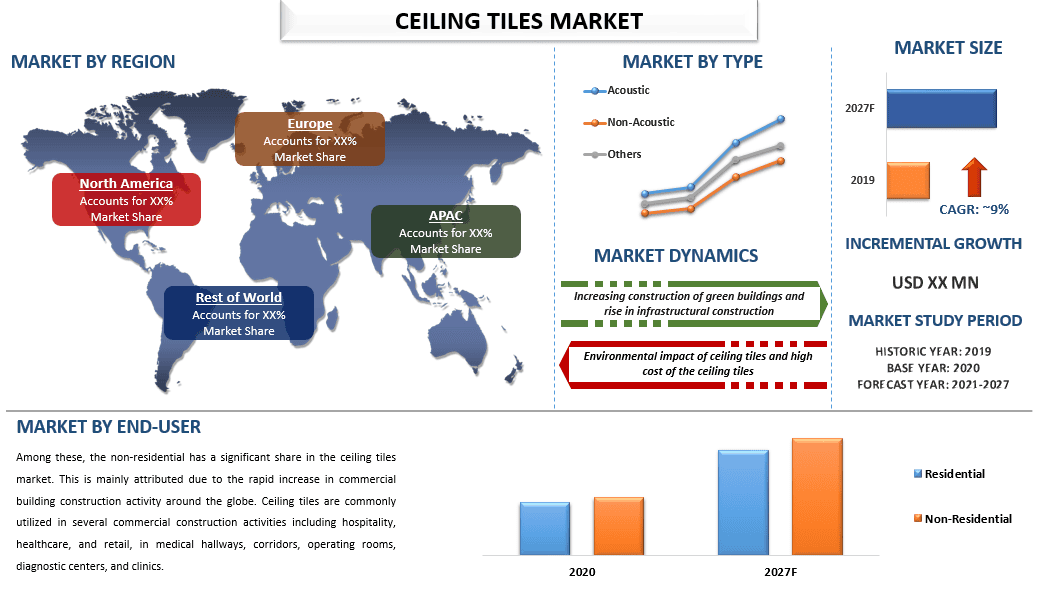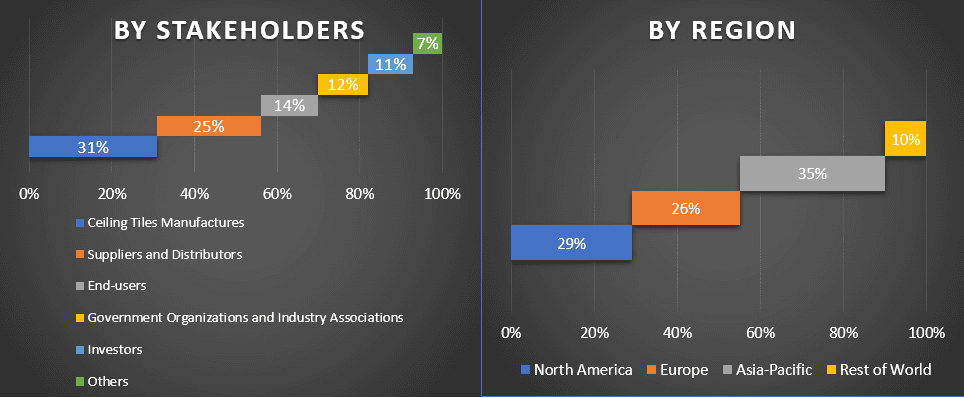Ceiling Tiles Market: Current Analysis and Forecast (2021-2027)
Emphasis by Material (Gypsum, Mineral Fiber, Metallic, Calcium Silicate, PVC, and Others); Type (Acoustic, Non-Acoustic, and Others); End-User (Residential and Non-Residential,); and Region and Country

The global ceiling tiles market is likely to showcase a growth of around 9% during the forecast period. Ceiling tiles or panels refer to lightweight construction materials primarily utilized in ceilings applications to enhance the interior exquisite. Ceiling tiles are mainly made from gypsum, metals, mineral fiber, PVC, wood, and others. These tiles provide numerous benefits over conventional cement-based ceilings, such as high thermal and acoustic insulation, better recyclability, easy installation, low-cost maintenance and repair, and improved aesthetics, among others. Owing to the above-mentioned properties, ceiling tiles are widely adopted for several construction activities across multiple sectors such as residential, retail, hospitality, healthcare, corporate, and others. The expanding construction industry coupled with the growing number of modern infrastructural projects is augmenting the market for ceiling tiles. Furthermore, the rising urbanization and the growing consumer inclination towards false and pleasing appealing ceiling structures are also fuelling the demand for ceiling tiles. Besides, the growing utilization of ceiling tiles in commercial buildings, such as multiplexes, shopping malls, and business centers for decorative and soundproof interiors is also augmenting the market growth. Additionally, various countries’ governments are investing in the construction and renovation of schools, hospitals, transport infrastructures, and public offices would drive the market for ceiling tiles.
Insights Presented in the Report
“Amongst materials, mineral fiber has a prominent share in the ceiling tiles market”
Based on material, the market is categorized into gypsum, mineral Fiber, metallic, calcium silicate, PVC, and others. Among these, mineral fiber has a prominent share in the ceiling tiles market as it offers benefits such as sound insulation, durability, resistance to fire, and light reflectance. They are extensively used in non-residential buildings such as offices, hospitals, retail stores, and others.
“Amongst type, acoustic has a considerable share in the ceiling tiles market”
Based on type, the market is categorized into acoustic, non-acoustic, and others. Among these, the acoustic has a considerable share in the ceiling tiles market. Acoustic is mainly utilized for sound control and noise reduction. The acoustic has three main categories such as sound-absorbing, sound-blocking, and sound diffusing ceiling tiles. The soundproofing tiles control noise in large or small areas to keep acoustics in balance for occupant comfort. High-density fiberglass boards, substrates like acoustical foam, and polyester are used as the primary material for the manufacturing of acoustic ceiling tiles.
“Amongst end-user, non-residential has a significant share in the ceiling tiles market”
Based on end-user, the market is categorized into residential, non-residential, and others. Among these, the non-residential has a significant share in the ceiling tiles market. This is mainly attributed to the rapid increase in commercial building construction activity around the globe. Ceiling tiles are commonly utilized in several commercial construction activities including hospitality, healthcare, and retail, in medical hallways, corridors, operating rooms, diagnostic centers, and clinics.
“Asia-Pacific has a considerable share in the global ceiling tiles market”
For a better understanding of the market adoption of ceiling tiles, the market is analyzed based on its worldwide presence in the countries such as North America (United States, Canada, Rest of North America), Europe (Germany, France, United Kingdom, Italy, Spain, and Rest of Europe), Asia-Pacific (China, Japan, India, Australia, and Rest of APAC), and Rest of World. Asia-Pacific has a significant share of the market and is expected to showcase substantial growth during the forecast period. This can be attributed to the rising consumer disposable incomes in developed and developing nations such as India, China, and others which would result in higher adoption of modern construction practices. Furthermore, factors such as significant population growth, urbanization, and ongoing commercial and residential remodeling operations would boost the regional market. Due to the expansion of the business sector, the bulk of the population in the region is migrating to big cities. This would increase demand for ceiling tiles from both commercial and residential areas for construction activities.
Reasons to buy this report:
- The study includes market sizing and forecasting analysis validated by authenticated key industry experts
- The report presents a quick review of overall industry performance at one glance
- The report covers an in-depth analysis of prominent industry peers with a primary focus on key business financials, product portfolio, expansion strategies, and recent developments
- Detailed examination of drivers, restraints, key trends, and opportunities prevailing in the industry
- The study comprehensively covers the market across different segments
- Deep dive country-level analysis of the industry
Customization Options:
The global ceiling tiles market can further be customized as per the requirement or any other market segment. Besides this, UMI understands that you may have your own business needs, hence feel free to connect with us to get a report that completely suits your requirements.
Table of Contents
Research Methodology for Ceiling Tiles Market Analysis (2019-2027)
Analyzing the historical market, estimating the current market, and forecasting the future market of ceiling tiles, three major steps are undertaken to create and analyze its adoption across the globe. Exhaustive secondary research was conducted to collect the historical market numbers and estimate the current market size. Secondly, to validate these insights, numerous findings and assumptions were taken into consideration. Moreover, exhaustive primary interviews were also conducted, with industry experts across the value chain of the ceiling tiles industry. Post assumption and validation of market numbers through primary interviews, we employed a bottom-up approach to forecast the complete market size. Thereafter, market breakdown and data triangulation methods were adopted to estimate and analyze the market size of segments and sub-segments of the industry pertains to. Detailed methodology is explained below:
Seek More Details About Research Methodology
Analysis of Historical Market Size
Step 1: In-Depth Study of Secondary Sources:
Detail secondary study was conducted to obtain the historical market size of ceiling tiles through company internal sources such as annual reports & financial statements, performance presentations, press releases, etc., and external sources including journals, news & articles, government publications, competitor publications, sector reports, third-party database, and other credible publications.
Step 2: Market Segmentation:
After obtaining the historical market size of the ceiling tiles market, we conducted a detailed secondary analysis to gather current market insights and share for different segments & sub-segments for major regions. The major segment is included in the report by material, type, and end-user. Further regional and country-level analyses were conducted to evaluate the overall adoption of ceiling tiles globally.
Step 3: Factor Analysis:
After acquiring the historical market size of different segments and sub-segments, we conducted a detailed factor analysis to estimate the current market size of ceiling tiles. Further, we conducted factor analysis using dependent and independent variables such as increasing adoption of eco-friendly products, and rising demand from the construction sector. A thorough analysis was conducted for demand and supply-side scenarios considering an increasing investment, top partnerships, mergers and acquisitions, business expansion, and product launches in the ceiling tiles industry.
Current Market Size Estimate & Forecast
Current Market Sizing: Based on actionable insights from the above 3 steps, we arrived at the current market size, key players in the global ceiling tiles market, and market shares of each segment. All the required percentage shares split, and market breakdowns were determined using the above-mentioned secondary approach and were verified through primary interviews.
Estimation & Forecasting: For market estimation and forecast, weights were assigned to different factors including drivers & trends, restraints, and opportunities available for the stakeholders. After analyzing these factors, relevant forecasting techniques i.e., the bottom-up approach were applied to arrive at the market forecast to 2027 for different segments and subsegments across the major regions globally. The research methodology adopted to estimate the market size encompasses:
- The industry’s market size, in terms of value (US$) and the adoption rate of ceiling tiles across the major markets
- All percentage shares, splits, and breakdowns of market segments and sub-segments
- Key players in the ceiling tiles market. Also, the growth strategies adopted by these players to compete in the fast-growing market
Market Size and Share Validation
Primary Research: In-depth interviews were conducted with the Key Opinion Leaders (KOLs) including Top Level Executives (CXO/VPs, Sales Head, Marketing Head, Operational Head, Regional Head, Country Head, etc.) across major regions. Primary research findings were then summarized, and statistical analysis was performed to prove the stated hypothesis. Inputs from primary research were consolidated with secondary findings, hence turning information into actionable insights.
Split of Primary Participants by Stakeholders and Regions

Market Engineering
The data triangulation technique was employed to complete the overall market estimation and to arrive at precise statistical numbers for each segment and sub-segment of the global ceiling tiles market. Data was split into several segments & sub-segments post studying various parameters and trends in the area of material, type, and end-user.
The main objective of the ceiling tiles market study
The current & future market trends of global ceiling tiles were pinpointed in the study. Investors can gain strategic insights to base their discretion for investments on the qualitative and quantitative analysis performed in the study. Current and future market trends would determine the overall attractiveness of the market at a country level, providing a platform for the industrial participant to exploit the untapped market to benefit as a first-mover advantage. Other quantitative goals of the studies include:
- Analyze the current and forecast market size of ceiling tiles in terms of value (US$). Also, analyze the current and forecast market size of different segments and sub-segments
- Segments in the study include the area of material, type, and end-user
- Defined analysis of the regulatory framework for the ceiling tiles industry
- Analyze the value chain involved with the presence of various intermediaries, along with analyzing customer and competitor behaviors of the industry
- Analyze the current and forecast market size of ceiling tiles for the major countries
- Major regions/countries analyzed in the report include North America (United States, Canada, Rest of North America), Europe (Germany, France, United Kingdom, Italy, Spain, Rest of Europe), Asia-Pacific (China, Japan, India, Australia, Rest of Asia-Pacific), and Rest of World
- Company profiles of the ceiling tiles market players and the growth strategies adopted by them to sustain the growing market
- Deep dive country-level analysis of the industry
Related Reports
Customers who bought this item also bought










